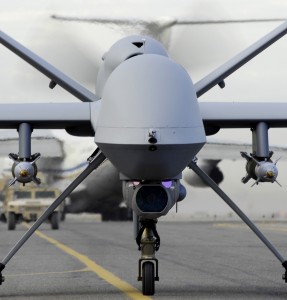OPINION: Drones will define us, absent new policy
We witnessed President Obama the community organizer in his counter-terrorism speech at National Defense University. The president even tried to hear out the heckler, telling the audience “the voice of that woman is worth paying attention to…”
Like it or not, listening to people -- some call it leading from behind -- is Obama’s style. His speech amounted to asking the American people and their elected representatives to help “define the nature and scope of this struggle” against terrorism. We should take him up on the invitation.
The president sent out a classified guidance to various agencies spelling out the criteria for drone strikes, but one has the sense that this won't be the last word. The president wants a “comprehensive” counter terrorism strategy, lest drone strikes and prisons come to define us. He says we're at a crossroads.
It's a crossroads, but it's one produced by domestic politics more than shifting facts on the ground. We're at the same strategic crossroads now that we were last year when the president said al Qaida was "on the run," or the year before when Osama bin Laden was killed in Pakistan.
After bin Laden’s death, Obama’s former director of national intelligence, Dennis C. Blair, tried to nudge his old boss toward a new road with an op-ed in the New York Times, declaring that “unilateral drone attacks” were serving to increase “hatred of America” in Pakistan.
The headline of Blair’s piece, “Drones Alone Are Not the Answer,” could have fit atop Obama’s speech
. Partnerhips, including with countries like Pakistan, will be part of the equation, as will foreign aid.
Obama’s epiphany is late, but late is better than never. A lot of issues need to be sorted out for a truly comprehensive approach, not just for this president but for those to come.
Obama’s speech suggests a throttling back of the drone war mostly because he thinks we can – “the scale of this threat closely resembles the types of attacks we faced before 9/11” – not that we should. Drone strikes were already down to a couple dozen a year from their peak of 117 in 2010, according to the tally by the Long War Journal.
A fundamental policy question has been left answered: Was killing more than two thousand people in Pakistan and Yemen strategically worth it?
It's hard to dispute the tactical success of the drone war – the core of al Qaida is now “on the path of defeat,” as the president said yesterday.
The strategic prices have been high, however. The president doesn’t want drone strikes to define America, but in many places they already do. The terrorist threat has morphed into suspected lone wolves like the Tsarnaev brothers in Boston and the attackers in London May 22.
That's not the only strategic price. The U.S. has been derelict as steward of the new weapon it pioneered with allies like Israel – the unmanned aircraft. The drone war will make it very hard for the U.S. and its partners to criticize countries that decide armed drones are the perfect solution for every insurrection. Drones are powerful weapons that can save lives through precise targeting, but using them for targeted killings beyond war zones should be rare.
Our challenge now is to untangle the national character from the drone war, and we can’t do that without an honest reckoning.
The president's speech and guidance show no fundamental change in the administration’s thinking about the threshold for using drones, a term that was once officially non grata but which the president used more than a dozen times.
Obama broke no new ground when he promised lethal strikes against only those “who pose a continuing and imminent threat to the American people.” In February, then-CIA director nominee John O. Brennan said much the same thing to the Senate Select Committee on Intelligence. Brennan said strikes are only launched when “we believe that the intelligence base is so strong, and the nature of the threat is so grave and serious, as well as imminent, that we have no recourse.”
A huge question is still hanging out there: What does imminent mean? To me, the Webster’s definition is clear enough: “ready to take place.” It's hard to believe that all the dead were about to attack Americans.
Before Obama’s speech, the White House saw room for interpretation about the meaning of imminent, and it still does. An administration official confirmed by email that the White House stands by Brennan’s 2011 speech at Harvard Law School in which he said a more “flexible understanding of ‘imminence’ may be appropriate when dealing with terrorist groups…”
Clearly, we still have a lot to work out, and the president deserves credit for starting the conversation.




“Drones are powerful weapons that can save lives through precise targeting, but using them for targeted killings beyond war zones should be rare”
What about the murder of non-Americans who are killed when drone strikes on a suspected target, I would again say suspected target. Along with these suspected targets many innocent people like women and children are killed. They are not American I understand. Are they not humans?
The use of unmanned aircraft systems aka UAS (let’s call them what they are – by definition, drones are a very narrow subset of UAS and one about as far removed from autonomous killer robots as you can get) for strikes is NO different than using cruise missiles or manned aircraft as were used in the 80s and 90s with recalcitrants like Libya, Iraq, and Serbia.
The UAS is not a thinking, self-guiding killing machine that decides for itself who should live and who should die. It is controlled by the same type of person, possibly in some cases even the same people, that flew manned strikes in the 90s i.e. trained and qualified human operators. the sensors onboard the UAS are the same as those on manned strike aircraft, as are the weapons. The only difference is that those operators are not at operational or political risk about the aircraft performing the strike. This is the main reason for the popularity of UAS strikes over manned aircraft strikes – no inconvenient Francis Gary Powers or O’Scott Grady to be used as pawns for leverage or just general embarrassment…
The targeting process is entirely separate from the strike process. Once the target is selected and confirmed according to whatever rules of engagement and collateral damage estimate processes that are in effect, it should be assigned to the most appropriate tool for the job – in many cases, this is not the UAS that is actually employed. UAS are just so attractive due to the perceived deniability and anonymity.
Have the dozens and dozens of UAS strikes outside the war zones of Iraq and Afghanistan achieved much in the way of reducing terrorism?
Probably not.
Have they, as Ben says above, served “…to increase “hatred of America”…” (and, by implication, the West)?
Probably.
All things considered, are they the right tool for the job?
Probably not.
Are they more of a convenient political expedient?
Probably.
The air strikes against suspected or known terrorists (Whether or not they are US citizens and whether this is actually relevant is just one big RED HERRING) are a form of asymmetric warfare – leveraging Western strength against terrorist weakness in the air domain. Perhaps the real question is whether those comfortable with such air strikes will be as comfortable should their enemies opt to conduct their own form of asymmetric warfare against those they perceive as ‘terrorists’ i.e. their adversaries in the ‘drone’ wars…?